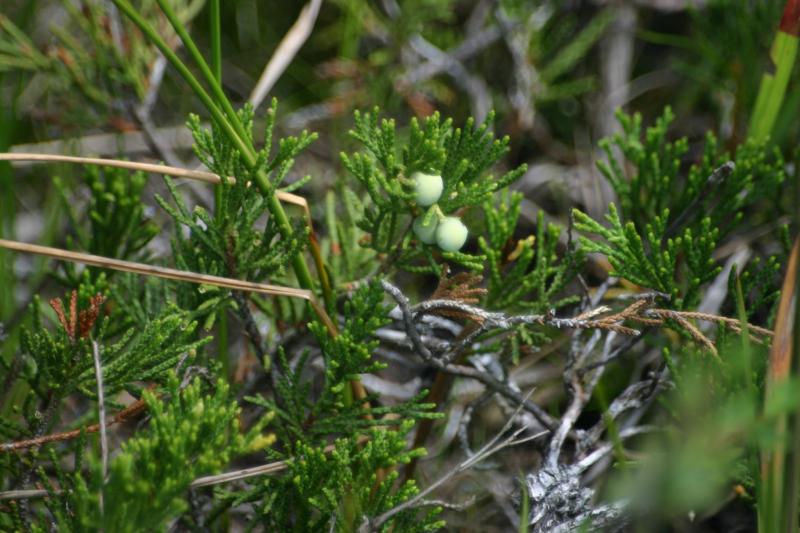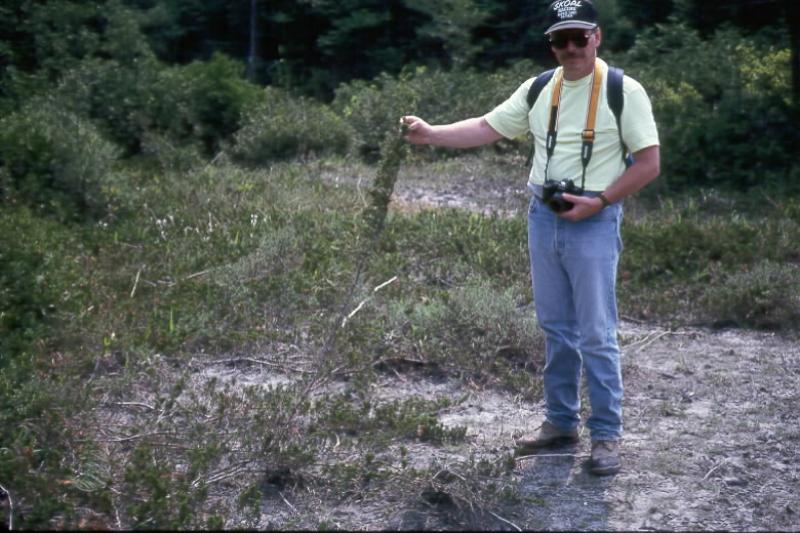Creeping Juniper
Juniperus horizontalis Moench
- Class
- Pinopsida (Conifers)
- Family
- Cupressaceae (Cypress Family)
- State Protection
- Endangered
Listed as Endangered by New York State: in imminent danger of extirpation in New York. For animals, taking, importation, transportation, or possession is prohibited, except under license or permit. For plants, removal or damage without the consent of the landowner is prohibited.
- Federal Protection
- Not Listed
- State Conservation Status Rank
- S1
Critically Imperiled in New York - Especially vulnerable to disappearing from New York due to extreme rarity or other factors; typically 5 or fewer populations or locations in New York, very few individuals, very restricted range, very few remaining acres (or miles of stream), and/or very steep declines.
- Global Conservation Status Rank
- G5
Secure globally - Common in the world; widespread and abundant (but may be rare in some parts of its range).
Summary
Did you know?
Creeping juniper is a popular landscape plant with many horticultural varieties in blues, greens and yellows. The NY Natural Heritage program only tracks native occurrences.
State Ranking Justification
This plant has always been rare and local in its distribution in New York. There are only two known populations today that are located in relative close proximity to one another. Further studies may indicate that the two "populations" are actually interacting with one another and best treated as two sub-populations of the same occurrence. There are a few more locales to search for this species, but few additional populations are suspected.
Short-term Trends
This plant has always been rare and local in its distribution in New York. There are only two known populations today and seven historical sites. These historical sites need further survey work. One site is known to be extirpated. Without further data, neither the short nor long-term trends can be determined.
Long-term Trends
More information is needed to determine the long-term trends. A few sites have probably been lost over the last 200-300 years, but this plant has likely always been rare in New York.
Conservation and Management
Threats
There are few known threats to this shrub, except that it may prefer more open habitats, therefore may be susceptible to natural succession. There is at least one known place where a planted stand has spread into a natural area. Historically, some of the sites where this plant was found may have been subjected to habitat conversion. Today this is not a significant threat.
Conservation Strategies and Management Practices
This shrub tends to be found in somewhat harsh but sensitive environments. No direct management is needed within these areas except to offer adequate protection to the habitat.
Research Needs
More research is needed to determine if the hybrid between Juniperus horizontalis and Juniperus virginiana is present in New York. In the past, this hybrid was known as Juniperus virginiana var. ambigens. Work on the spread of the plant populations and its potential genetic interactions with native stands may be worthwhile.
Habitat
Habitat
A prostrate evergreen shrub that is found in marl fens, in rich sloping fens, along river banks, and other wetland types associated with limestone (New York Natural Heritage Program 2005). Sand dunes, sandy and gravelly soils, prairies, slopes, rock outcrops, and stream banks (Flora of North America 1993). Rocky or sandy places (Gleason and Cronquist 1991). Almost entirely confined to the sandy or gravelly shores (including dolomite pavement) and dunes of the Great Lakes, usually associated with pine and the common juniper [Juniper communis] and relic on older shores and beach ridges among cedar and fir thickets; inland in alder thickets and rocky woods (Voss 1972). Rocky or sandy banks, mossy bogs, etc. (Fernald 1970).
Associated Ecological Communities
- Marl fen
(guide)
A wetland that occurs on a bed of marl. Marl is a whitish substance that is deposited from water that has a lot of calcium dissolved in it. The whitish substance is calcium carbonate, people used to harvest marl to lime agricultural fields. The marl substrate is always saturated, may be flooded, and has a very high pH, generally greater than 7.5. The main source of water is always groundwater. The plants are often sparse and stunted. Marl fens may occur as small patches within a rich graminoid fen.
- Rich graminoid fen
(guide)
A wetland of mostly grasses usually fed by water from highly calcareous springs or seepage. These waters have high concentrations of minerals and high pH values, generally from 6.0 to 7.8. Plant remains do not decompose rapidly and these grasses usually grow on older, undecomposed plant parts.
- Rich sloping fen
(guide)
A small, gently sloping wetland that occurs in a shallow depression on a slope composed of calcareous glacial deposits. Sloping fens are fed by small springs or groundwater seepage. Like other rich fens, their water sources have high concentrations of minerals and high pH values, generally from 6.0 to 7.8. They often have water flowing at the surface in small channels or rivulets.
- Riverside ice meadow*
(guide)
A meadow community that occurs on gently sloping cobble shores and rock outcrops along large rivers in areas where winter ice floes are pushed up onto the shore, forming an ice pack that remains until late spring. The ice scours the meadow, cutting back woody plants.
- Riverside sand/gravel bar*
(guide)
A meadow community that occurs on sand and gravel bars deposited within, or adjacent to, a river channel. The community may be very sparsely vegetated, depending on the rates of deposition and erosion of the sand or gravel.
* probable association but not confirmed.
Associated Species
- Juniperus communis var. communis (Eurasian common juniper)
- Scleria verticillata (low nut sedge)
- Solidago ohioensis (Ohio flat-topped-goldenrod)
- Thuja occidentalis (northern white cedar, arbor vitae)
- Tofieldia glutinosa
- Triglochin palustris (marsh arrow-grass)
Range
New York State Distribution
Native populations are found along the Niagara Escarpment from Syracuse westward. New York is at the southeast edge of the native range of this plant. This plant is also available through various nurseries and has escaped cultivation in a few areas (e.g. Valcour Island).
Global Distribution
This shrub is present in scattered locations in a narrow band that stretches from Newfoundland and southern Maine, west through the Great Lakes region to northern Colorado and Wyoming, and extending northward to the Yukon Territory.
Identification Comments
General Description
Creeping juniper does what its name implies and grows along the ground in dense mats no more than 2 feet tall and 4-8 feet wide. The peeling, reddish brown bark is obscured by the thick overlapping mat of branches. The evergreen leaves are mostly scale-like and pressed close to the branches but needle-like leaves can also be found as in other junipers. Obscure flowers produce blue, berry-like cones containing 3-5 seeds.
Identifying Characteristics
The key factor identifying this shrub is its prostrate nature where the branches creep along the ground. These branches may extend many meters, but the side branches are typically never more than 30 cm from the ground. The scale-like appressed leaves are usually arranged opposite one another. Each blue cone has 3-5 smooth seeds.
Best Life Stage for Proper Identification
This prostrate shrub can be identified at any time during the year when the leaves are visible. To make a positive identification, a full description of the habitat is needed. Notes about the growth habit of the plant are also needed. A photo or specimen should be taken as a voucher.
Similar Species
Based on leaf material only, Juniperus horizontalis and Juniperus virginiana are very similar and difficult to distinguish. The key difference is Juniperus horizontalis is a prostrate shrub, while Juniperus virginiana is an erect shrub or tree. The cones of Juniperus horizontalis has 3-5 smooth seeds, while Juniperus virginiana has 1-2 seeds with shallow pits. Juniperus communis may also grow prostrate, but it has leaves in threes and these are typically linear and sharp-pointed.
Best Time to See
This evergreen shrub is visible year-round, as long as it is not buried by snow. Mature cones are typically present from late May to early September, or longer. Surveys may be conducted at any time, assuming there is not too much snow present.
- Vegetative
- Fruiting
The time of year you would expect to find Creeping Juniper vegetative and fruiting in New York.
Creeping Juniper Images
Taxonomy
Creeping Juniper
Juniperus horizontalis Moench
- Kingdom Plantae
- Phylum Coniferophyta
- Class Pinopsida
(Conifers)
- Order Pinales
- Family Cupressaceae (Cypress Family)
- Order Pinales
- Class Pinopsida
(Conifers)
- Phylum Coniferophyta
Additional Common Names
- Creeping Cedar
- Creeping Savin
- Prostrate Juniper
- Shrubby Red Cedar
Synonyms
- Juniperus hudsonica Forbes
- Juniperus prostrata Pers.
- Juniperus repens Nutt.
- Juniperus sabina var. horizontalis Hort.
- Sabina horizontalis (Moench) Rydb.
- Sabina prostrata (Pers.) Antoine
Comments on the Classification
Hybrids between Juniperus horizontalis and Juniperus virginiana have been reported from Wisconsin and Maine. Since both species are present in New York, hybrids should be searched for at sites where both species are present nearby.
Additional Resources
Best Identification Reference
Gleason, Henry A. and A. Cronquist. 1991. Manual of Vascular Plants of Northeastern United States and Adjacent Canada. The New York Botanical Garden, Bronx, New York. 910 pp.
Other References
Fassett, Norman C. 1945. Juniperus virginiana, J. horizontalis, and J. scopulorum - V. Taxonomic Treatment. Bulletin of the Torrey Botanical Club 72(5): 480-482.
Fernald, M.L. 1950. Gray's manual of botany. 8th edition. D. Van Nostrand, New York. 1632 pp.
Flora of North America Editorial Committee. 1993. Flora of North America, North of Mexico. Volume 2. Pteridophytes and Gymnosperms. Oxford University Press, New York. 475 pp.
Holmgren, Noel. 1998. The Illustrated Companion to Gleason and Cronquist's Manual. Illustrations of the Vascular Plants of Northeastern United States and Adjacent Canada. The New York Botanical Garden, Bronx, New York.
Mitchell, Richard S. and Gordon C. Tucker. 1997. Revised Checklist of New York State Plants. Contributions to a Flora of New York State. Checklist IV. Bulletin No. 490. New York State Museum. Albany, NY. 400 pp.
New York Natural Heritage Program. 2010. Biotics database. New York Natural Heritage Program. New York State Department of Environmental Conservation. Albany, NY.
New York Natural Heritage Program. 2024. New York Natural Heritage Program Databases. Albany, NY.
Reschke, Carol. 1990. Ecological communities of New York State. New York Natural Heritage Program, New York State Department of Environmental Conservation. Latham, NY. 96 pp. plus xi.
Voss, E.G. 1972. Michigan Flora, Part I. Gymnosperms and Monocots. Cranbrook Institute of Science Bulletin 55 and the University of Michigan Herbarium. Ann Arbor. 488 pp.
Weldy, T. and D. Werier. 2010. New York flora atlas. [S.M. Landry, K.N. Campbell, and L.D. Mabe (original application development), Florida Center for Community Design and Research http://www.fccdr.usf.edu/. University of South Florida http://www.usf.edu/]. New York Flora Association http://newyork.plantatlas.usf.edu/, Albany, New York
Links
About This Guide
Information for this guide was last updated on: March 21, 2005
Please cite this page as:
New York Natural Heritage Program. 2024.
Online Conservation Guide for
Juniperus horizontalis.
Available from: https://guides.nynhp.org/creeping-juniper/.
Accessed July 27, 2024.

